Future-proofing is a term often thrown around liberally these days – indeed, for designers and product planners, it’s their job to make sure that their offerings remain relevant for the entire duration of them being put up for sale.
But these are turbulent, uncertain days, as everyone scrambles around to figure out the sort of lives citizens of the imaginary perfect utopian future live, and quite often the new products sent out to test the waters can receive a not-so-perfect reception by the buying public. It’s no wonder companies tend to be so conservative nowadays, catering only to what the current population wants, not what it wants to be.
Which is why Ford’s bold 2011 reimagining of its regional breadwinner, the Ranger, was so inspired. The sophistication and refinement built into the T6 iteration was hitherto unheard of – it was a move so shrewd in predicting the quickly changing tastes of the market that only recently have competitors started to catch up.
Four years later, the same treatment is finally extended to the Ranger’s oft-forgotten SUV sibling, the Ford Everest. The company promises plenty for its latest offering (due to arrive in November), but with a recently-introduced rival from Isuzu and strong contenders from Toyota and Mitsubishi coming on stream soon, can the Everest even keep up with the Joneses, let alone push forth a path towards the future? We ventured into the dense jungles of Chiang Rai – sampling both 2.2 litre 4×2 and 3.2 litre 4×4 variants – to find out.
The Ranger – even in its current pre-facelifted form – is by far our favourite pick-up, and you only need to drive a few kilometres to see why. The cabin is well-isolated from road and wind noise, and the Blue Oval wipes the floor with the competition in terms of ride comfort and handling precision, even if it doesn’t quite reach passenger car levels. Throw in the modern square-jawed styling, strong engines and excellent kit and suddenly the high expectations for the new Everest seem justified.
Well, in terms of appearance at least, the Everest does improve on the Ranger’s already good looks. The completely revamped face – mostly shared with the updated Ranger, bar the grille and front bumper – features a new interpretation of Ford’s three-bar truck grille design, now opened up and housed in a trapezoidal outline.
Flanking it are slimmer headlights – halogen and xenon projector units (the latter with LED daytime running lights) are fitted on higher-end variants. Underneath the grille sits a broad air inlet framed by a U-shaped bar (black on base models, silver on others) that extends both outwards to encircle the rectangular fog lights and downwards to form the skid plate.
Even the bonnet and front fenders are new – the former has been reshaped with more strakes across the top surface, while the (non-functional) fender “vents” are bolder. Certainly, the new face is more stylish and sophisticated, if a little more homogenised compared to the current Ranger.
As you’d expect, everything aft of the B-pillars is all-new – a rising beltline, sloping D-pillar and black appliqués on either side of the windscreen create the impression of a steeply-raked rear, neatly disguising this seven-seater’s blocky profile. At the rear, C-shaped LED tail lights sit inside chiselled surrounds and are connected by a horizontal chrome bar, while a skid plate housing the rear fog lights mirrors the one in front.
Overall, the Everest has certainly moved the game on considerably from its predecessor – it has a far classier aesthetic and manages to hide its truck roots a lot more convincingly, while still maintaining the hulking macho physique favoured by buyers in this segment.
However, while it’s definitely a handsome thing to behold (especially on the massive 20-inch wheels on the top-spec Titanium model), it does feel a little bit conservative next to the more extroverted and futuristic designs of the new Toyota Fortuner and Mitsubishi Pajero Sport.
Thankfully, there are no such qualms with the interior, which looks every bit as up-to-date as it should be. The dashboard is all-new on the Everest (and is also shared with the facelifted Ranger) and swaps a great big edifice of a centre console – which, while distinctive, would’ve jarred with the upmarket move elsewhere – with a more horizontal design.
And while the more luxurious look is still let down by hard plastics that dominate the cabin, Titanium models get a soft-touch upper dashboard panel, with real topstitching – none of the Toyota Vios‘ fake moulded stuff, thank you very much. Choose this variant, however, and you do lose out on the central tray fitted to the rest of the lineup.
In terms of trim, a matte silver fascia is used on most models, but the Titanium receives a glossy grey finish complete with a large “Everest” badge in front of the passenger. It’s a nice touch, mirrored in the illuminated side sills that add a further premium touch to the cabin.
Although a beige interior is available, our cars will be black; this hides the rougher, cheaper feeling bits of the cabin, but it does make the car look a trifle dour, especially with the Titanium’s black upper environment (pillars, headlining) and the aforementioned darker trim. Thankfully, chrome highlights around the cabin lift the mood slightly.
Taking centre stage on higher-end models is Ford’s SYNC 2 infotainment system, incorporating an eight-inch touchscreen. First seen locally in the new Mondeo, the second-generation system is split into four quadrants for phone, entertainment, navigation (vehicle information on cars without navigation) and climate options, although there are analogue controls for audio and air-conditioning lower down.
While reasonably quick to respond, the touch interface can be rather tricky to navigate. Those four sections aren’t very clearly marked, making them quite difficult to discern at speed. Also, some of the controls – particularly for the dual-zone automatic climate control – are very tightly packed, so the screen looks cluttered even though it’s quite logically laid out.
That would be fine if the redundant controls were intuitive to use; on the Everest, however, they are placed quite far down. Worse still, they face downwards and aren’t equipped with separate displays, so you still have to look at the upper screen while reaching downwards to manipulate the buttons and dials.
It’s all rather intimidating for the uninitiated – at one point I gave up trying to adjust the air-conditioning and simply asked my co-driver to do it for me. It’s a good job you can also use the new voice control feature, which now understands more natural language commands compared to that on the original SYNC system.
The same criticisms can be levelled at the twin four-inch digital displays flanking the central analogue speedometer, customisable via two four-way controllers on the steering wheel.
It’s a brilliant idea on paper, but the execution leaves much to be desired, often requiring you to dive through the menus to access all the different screens available. Jumping to the rev counter from the fuel economy stats screens is a particular pain, although the former is so small as to be rendered almost completely useless, so it’s pretty much moot to view it in the first place.
The six buttons on each side of the steering wheel to control telephony and cruise control options are also contentious – again, they’re placed on the lower surface of the spokes, which makes them quite difficult to reach to, although it gets easier with use.
Elsewhere, however, cutting-edge technology has in many ways given way to simple practicality. You sit high up, commandeering over the roads, with the optional powered front seats providing a broad range of movement to suit most body types. The only black mark in the Everest’s book here is the lack of telescopic steering wheel adjustability, which rather clashes with the SUV’s upmarket aspirations.
Head-, leg- and elbowroom is aplenty in the first and second rows, but the third row feels a little more cramped than, say, the Isuzu MU-X, with a bit less legroom and just as little headroom. Fortunately, there are air vents above both the second and third rows that effectively cool the entire cabin, with temperature and fan speed controls behind the front armrest.
Entry and egress into the rearmost pews is also somewhat more restricted than in its competitors, because the second-row seats merely slide forwards rather than tumble – Ford has instead opted to sacrifice this functionality in favour of a sliding middle row (it’s a more crossover-esque layout than its competitors; a theme that manifests itself again later on).
The Everest counters by having nearly double the MU-X’s boot space with all seats up (450 litres versus 253), which can be expanded to 2,010 litres (MU-X 1,830 litres) with both second- and third-row seats folded flat. But the figures only tell half the story – the Ford also features a lower load floor than the Isuzu (mostly thanks to the Everest not featuring a storage box at the rear, which makes loading items a pain in the MU-X).
Back here, however, the real party piece (on the Titanium, at least) comes in the shape of a power-folding third row. No, not a powered seat back release like you get on the BMW 2 Series Gran Tourer – these seats will literally fold (boot space is 1,050 litres in this mode) and unfold at the touch of a button. More frequently found on American SUVs and MPVs, it’s a feature we can totally get behind.
There are other goodies as well, ranging from a full-sized 230 V/150 W power socket in the second row and Active Park Assist to a panoramic sunroof and a powered tailgate. Safety-wise, you can specify a maximum of seven airbags, stability control, Adaptive Cruise Control with Collision Warning, Lane Keeping System and Blind Spot Information System with Cross Traffic Alert.
On a pick-up-based SUV, that’s quite an impressive roster. Do note, however, that because of the price-sensitive nature of our market, some of these toys may not be available in our market – we already know we won’t receive the powered tailgate, sunroof and Active Park Assist, not even on the top-spec Titanium.
Measuring 4,892 mm long, 1,860 mm wide and 1,837 mm tall, the Everest is comfortably the largest in its class, being 67 mm longer than the MU-X, 97 mm longer than the new Fortuner and a whopping 107 mm longer than the new Pajero Sport.
While the Ford is the same width as the Isuzu (and 5 mm wider than the Toyota and 45 mm wider than the Mitsubishi), it’s 23 mm lower; the Fortuner and Pajero Sport are 2 mm and 32 mm lower respectively. Another stat where the Everest trumps the rest is the wheelbase – at 2,850 mm, it’s 5 mm longer than the MU-X, 50 mm longer than the Pajero Sport and 100 mm longer than the Fortuner.
Headlining the updated lineup of engines is the new 2.0 litre EcoBoost turbo petrol that kicks out 241 hp and 360 Nm, but that won’t make it on our shores. Instead, we’ll get the familiar 2.2 litre four-cylinder and 3.2 litre five-cylinder Duratorq TDCi turbodiesels, shared with the Ranger.
These oil burners get a number of updates, including a new direct injection system; as a result, the 2.2 litre mill develops 158 hp at 3,200 rpm and 385 Nm from 1,600-2,500 rpm, compared to 148 hp and 375 Nm on the current Ranger. Also promised are improvements in fuel economy and emissions.
The larger 3.2 litre five-pot retains the same amount of power and torque – 197 hp at 3,000 rpm and 470 Nm from 1,750-2,500 rpm – but features an improved exhaust gas reciculation (EGR) system for better efficiency. A six-speed automatic transmission will be standard across the range in Malaysia; a six-speed manual is available as an option in other markets.
Under the skin, Ford claims there’s an all-new ladder frame that’s almost entirely unique to the Everest, with only the engine and gearbox mounts carried over from the Ranger. Apart from standard rear-wheel drive on the 2.2 litre model, there’s also four-wheel drive for the 3.2 litre Titanium, but it’s not the part-time system you’d find on the Ranger or its rivals.
Yes, it’s a full-time all-wheel drive setup instead – much like many unibody SUVs on the market – with a two-speed active transfer case providing Torque on Demand. The standard torque split is 40:60 front-to-rear, shifting to 20:80 at a cruise, but the system can send close to 100% of the engine’s power to either end. There’s also a low-range mode and an electronic locking rear differential, activated via buttons on the transmission tunnel.
The entire system can be manipulated using a dial next to the gear lever, which controls the Terrain Management System (TMS). There’s a strong whiff of Land Rover in this – it manages the Everest’s throttle response, transmission, traction control and torque split depending on the four different modes available: Normal; Snow, Mud and Grass; Sand and Rock. A button in the centre of the dial operates Hill Descent Control, with the speed of descent adjustable via the cruise control buttons on the steering wheel.
Even the front suspension, usually shared among pick-up and SUV counterparts, is completely different on the Everest – there’s an independent MacPherson strut setup instead of the Ranger’s double wishbones. Rear- and four-wheel drive models get separate tuning to account for weight, centre of gravity, drive configuration and torque distribution.
At the rear, a trailing-arm suspension system is used, and coil springs take the place of the Ranger’s leafs; the shock absorbers are mounted outboard of the frame rails for added stability and control on rough roads. The solid rear axle is retained for superior off-road and towing capabilities.
Restricting the axle’s lateral movement is a Watt’s linkage, consisting of two horizontal rods that link a short vertical bar at the centre of the axle to either ends of the chassis. This enables the axle to trace a vertical line more closely than with the simpler, cheaper and more common Panhard rod, allowing engineers to more tightly control steering and handling characteristics without having to compensate for inherent asymmetry.
Setting off, the first thing you notice is just how quiet the new Everest is. Features like double door sealing already make the Ranger fairly hushed, but its SUV sibling takes it to a whole other level. To start with, cabin sealing has been optimised, and extra sound deadening material has been added to the doors, roof and body. There’s also an acoustic windscreen on some models.
On top of that, Ford has fitted Active Noise Cancellation technology, utilising three microphones in the headliner – two in front, one at the rear – to pick up boomy low-frequency engine noise at lower engine speeds. The system then generates opposing sound waves through the speakers to cancel out any potentially undesirable noise between 30-180 Hz.
The net result is that road and wind noise is almost non-existent even at higher speeds, and at low revs neither engine make their presence known at all. It’s only when you rev either engine out that they become quite vocal, with the 3.2’s note being particularly raucous at higher revs. It’s not entirely unpleasant, however – you can hear the faint trace of a five-cylinder’s signature warble here.
Despite the higher output, the 2.2 litre model doesn’t feel all that sprightly compared to the current Ranger 2.2, presumably due to the added weight of a full body, an extra two seats and all that tech. Don’t get me wrong, however – this is still a punchy motor, able to adequately pull the big brute along from low down and put its power down smoothly and linearly throughout the rev range.
Of course, the smaller mill is no match for the 3.2 litre unit, which makes the Everest positively jump when floored, thanks to the almost 100 Nm surfeit of torque.
The six-speed auto is a decent pairing with either engine; it rows through the gears smoothly, if a tad leisurely. Its insistence of higher ratios – normally an annoyance on other cars – is also a boon here, keeping revs low and letting the abundance of low-end torque on both 2.2 litre and 3.2 litre models do all the legwork. It keeps engine noise and fuel consumption down, too.
Cruising over pockmarked Chiang Rai tarmac, the Everest’s compliance beggared belief, especially compared to the pogo-like ride of the MU-X. The Ford feels taut, composed, soaking up surface imperfections with aplomb; only when traversing high-frequency bumps does a boat-like side-to-side motion start to show itself, betraying the SUV’s truck underpinnings.
It’s off the beaten path where the Everest’s comparatively stiff suspension starts to show up its weaknesses – you’ll be tossed around quite a fair bit over deep ruts and rocky outcrops. That said, it’s hardly what you’d call unbearable, and it’s something most buyers would happily trade for the impressive on-road comfort.
More to the point, with a 225 mm ground clearance, an 800 mm water wading limit and high approach (29.5 degrees), breakover (21.5 degrees) and departure (25 degrees) angles and all the electronic wizardry on board, the Everest should still be quite a capable all-terrain vehicle and more than worthy of the name; it certainly made light work of the moderately challenging off-road section of our test route.
But it’s the Everest’s handling that truly impresses. Of course, it’s no Lotus Elise – this is a two and a half tonne body-on-frame SUV, and it makes no pretence otherwise. That said, it’s still mightily competent considering its size and scope, and absolutely trounces its rivals when the roads get twisty.
Roll is inevitable for something so tall and heavy, but the Everest corners flatter than the competition, and also feels a lot more agile. Ford uses electric power steering for the new Everest – which it claims is first in the segment – resulting in a light tiller at low speeds, making it a great deal easier to manoeuvre in urban environments than the rest.
At higher speeds, the system piles on more weight for greater sense of stability. Indeed, it does feel more surefooted through quicker bends with the added heft, but while it’s fairly accurate, feel and response still leaves much to be desired.
Two new technologies help drivers stay on the road. The first is Curve Control, which senses if you’re barreling into a corner too fast, and cuts engine torque and applies four-wheel braking, slowing the Everest down by as much as 16 km/h in one second. There’s also Roll Stability Control which uses gyroscopes to detect fast or sharp manoeuvres and brakes individual wheels to reduce the likelihood of a rollover.
Whichever way you slice it, the new Everest is a towering achievement. This is not just a Ranger with a canopy and two extra seats – it’s packed with technology and brings unmatched levels of refinement, ride and handling to what has often been viewed (quite rightly so, I might add) as quite an uncouth class of vehicles.
Of course, a proper verdict will have to wait until a proper test, not only of the Ford but also the new Fortuner and Pajero Sport, but on first blush the new Everest looks more than capable to spar with the increasingly heated competition, such is its depth of capability.
But for all of the SUV’s achievements, it could stumble before it even leaves the sprinting blocks, and that’s because of the decidedly upmarket tentative pricing. Even the base 2.2 XLT 4×2 – which we hear will be fairly bare boned – is slated to cost a considerable RM180k (that’s already pricier than all its rivals), with the 3.2 Titanium 4×4 pushing well beyond the RM200k barrier at RM230k-240k
It remains to be seen if the market can take up to paying so much money for a pick-up-based SUV when it arrives this November – even one that’s as talented as this. Only time will tell, but one thing’s for certain – the new Ford Everest is an accomplished vehicle, and one that deserves as much success as any.
UPDATE: The new 2016 Ford Everest is now available in Malaysia, priced at RM198,888 for the 2.2 Trend 2WD and RM258,888 for the 3.2 Titanium AWD. Both prices are on-the-road without insurance, inclusive of a three-year/100,000 km warranty.
Looking to sell your car? Sell it with Carro.


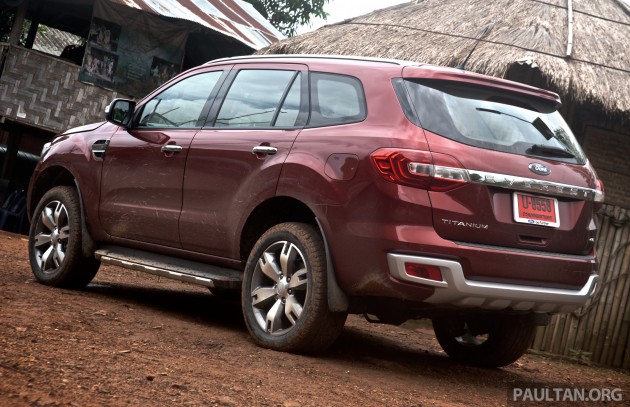



















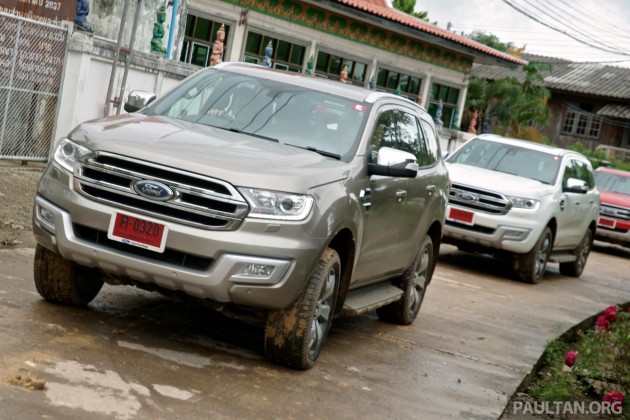

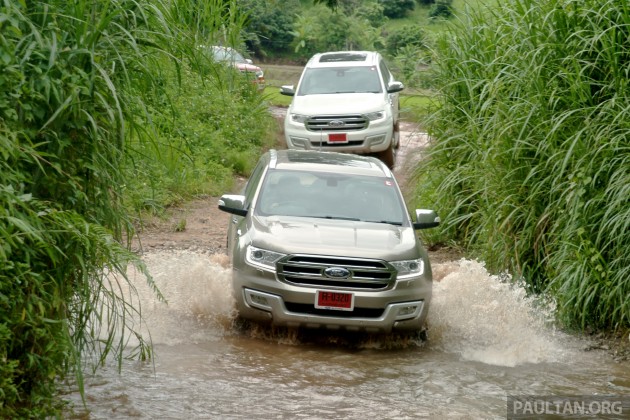
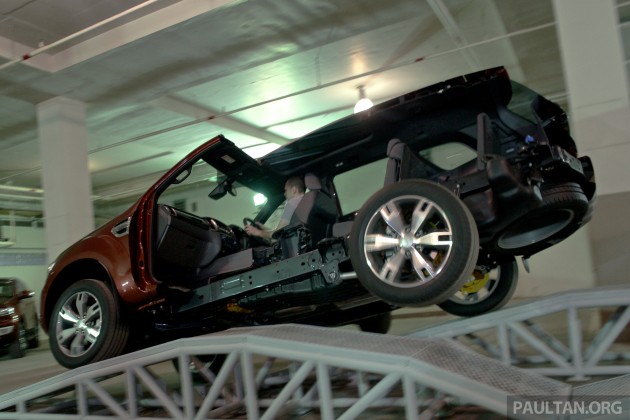

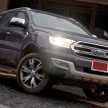
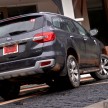
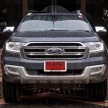
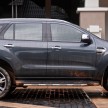
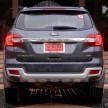
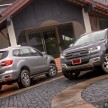
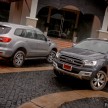

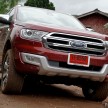
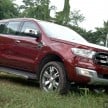
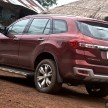
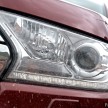
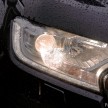
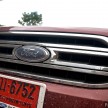
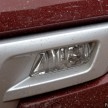
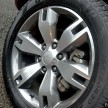
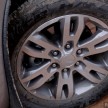
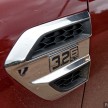
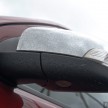
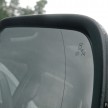
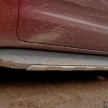
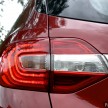
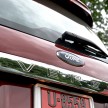
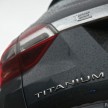
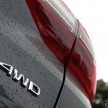
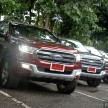
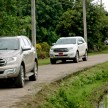
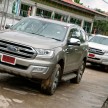

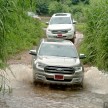
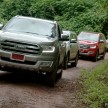
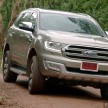
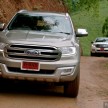
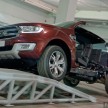

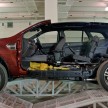
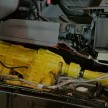
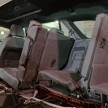
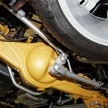
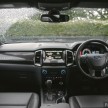
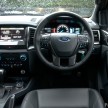

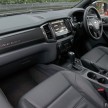
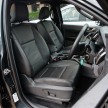
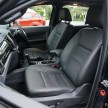
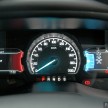
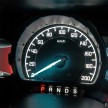
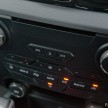
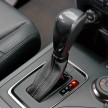
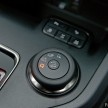
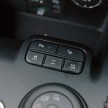
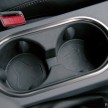
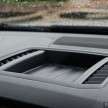
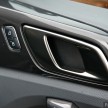
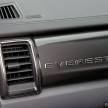
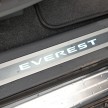

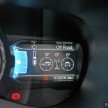
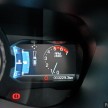
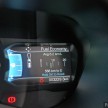
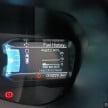
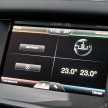
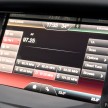
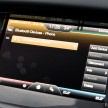
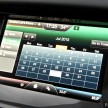
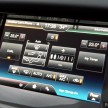
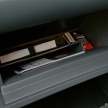

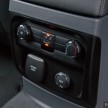
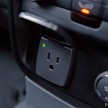
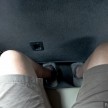
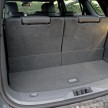
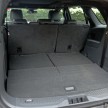
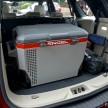
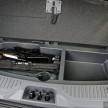
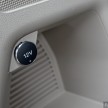
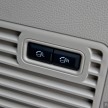
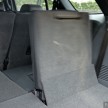
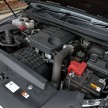
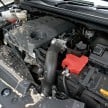











Pass 200k for this? In this crappy economy? Good Luck
It isn’t using dual clutch. Instead it is using a good old fashioned torque converter as seen on the new Mondeo and Kuga.
Common’, who the hack are you really?
Whenever there’s a Ford article, you’ll come out with this “taking Len Seng bus to work”, “3 months wait” bla bla bla…
You bloody article has only 2 points 1) 3 months wait, 2)Dry Clutch, you even try to bitch about the manual Fiesta ST which instantly get you grilled by other readers.
And you said your Focus was hold for 3 months at last year right? But I saw your writing the same thing back in 2012! Sometimes you disguised yourself as a Ford owner, sometimes you say you heard someone waited 3 months for a side mirror…. Which one of your version is lying? Seriously? You have been bitching about 3 months wait part and taking Len Seng Bus to work in EVERY FORD ARTICLE appear in Paultan since 2012!!!???
You have memory problem? Are you sure your accident was really last year? Or did you even own a Focus at all? Your really show how much you “love” your Ford even though it is plagued by so many problems for so many years! Why not just sell your Focus and buy another car?
Maybe you’re a salesman from other brand, or you must be very stupid to keep your problematic Focus for so many years while doing nothing except bitching in every Ford article in Paultan since 2012 with your 3 months wait and Len Seng bus stories.
You wrote the same thing back in 2013 saying your bumper kena bang:
http://paultan.org/2013/09/23/driven-ford-fiesta-1-5-sport-facelift-sampled/
So, you buy a 2014 Focus, but you have been bitching about Ford spare part and your 3 months wait stories in Paultan back in 2012! You must be very stupid indeed.
Are you really sure your accident was last year? Next time wanna badmouth Ford, be more professional a bit, don’t write contradictory timeline in your comments. Yeah right, you’re a 2014 Focus owner, just like Paris Hilton is a virgin.
While I would like to call bullshit on your post, one thing I can agree on is the unsatisfactory service experience of Ford.
My 2014 Fiesta had a problem with the gearbox where it would jerk and stutter when shifting from P > D directly.
Sent it for service claim, which I had to leave my car there for 2 weeks. They claimed the issue was with the gearbox being imported from overseas.
Service is definitely bad, but not as exaggerated as you have described.
Hi, sorry to hear about your Ford experience.
Yes, the waiting period for a clutch replacement is about 2 weeks, and your car has to vibrate at a certain frequency to be qualify for a warranted replacement. Pls refrain sending your car to SDAC PJ, it’s notoriously known for its long waiting period, lacklustre staff and unprofessionalism.
If you’re convenient, pls send your Fiesta to Ford Puchong, they’re much more helpful and have a much less waiting period.
Finally, regarding the Powershift, pls don’t drive it like a normal torque converter as it’s a dual-clutch, direct fly-wheel contact gearbox. In another words, it’s a manual with automatic clutch control. Pls observe 2 driving tips and see how it goes:
1) Try to use S mode and shift the gears by yourself (just like driving a manual), this will minimised the very sensitive and over fuel-saving prioritised gearbox TCU from shifting too often, which will save your clutch longevity in the long run.
2) Don’t “ride the clutch” in a traffic jam situation. Unlike a normal torque converter, pls don’t engage “D” and “drag” the car without throttle input and using only break control. By doing this, you’re actually “riding the clutch” by using the clutch friction to propel the car, this will generate lots of heat of friction that will kaput the gearbox prematurely. In a traffic jam, always press the break in full pedal, the gearbox TCU will sense you’re coming to a complete stop and disengage the clutch. If you merely “touching” on the break pedal, the TCU will think you’re going to launch immediately and will use the clutch to “makan” the flywheel, which in long run, will surely kaput the clutch pack, just like a manual car.
In short, always press the brake in full paddle traffic jam situation, nevermind the car in front has move or the car behind you is honking you. Always practice a complete stop and solid launch from stop will save your clutch in the long run. You can also use S mode to hold the gear in 1 or 2 to minimised the vibration and shuddering. Not only Ford owners, many DSG owners also kaput their gearbox because they “ride the clutch” too often in traffic jams.
Conclusion: The Powershift is actually a manual-box missing the clutch paddle, which the computer did the clutch work for you. Drive it like a manual and you should see great improvement in vibration elimination and clutch pack longevity. Cheers
owners just want to drive automatic car in peace…waa so many do’s and dont’s ah
2.2 litre engine underpowered, 3.2 litre engine too thirsty/road tax too expensive.
How?
Easy. Disable your EGR. Since it is fitted with vnt, no need to boost the turbo. Change the downpipe. Then you will notice a little gain. 2nd steps, maybe remap or using UNICHIP. Change whole exhaust system.
Looks way better than the Pajero Sport!
A very good looking car. Even more surprising that its based on a truck – cos it doesn’t look like it. Good job by Ford there. And while those 20 inch rims are very handsome, the owner might not find it such a good idea if the Everest is going to be driving into construction sites or offroad.
I am surprised that it has such a small and almost unreadable rev counter. I would’ve made the centre counter a rev counter instead of speedometer and put a digital number display inside it to show the speed. Knowing the revs is important in a car like this, especially when you have to take it offroad.
why so expensive? 180k for 3.2 everest cant? stupid malaysia car tax
SDAC will live off government purchase of this as fleet.
Omg la i wanna buy this car. Really thanks to najis now usd going to 4.0
!!!!!!!!!!! Wtf!!!!!!
Gratulations for this very detailed review!
I like the more «rough, off-roader» style of the new Everest.The new Fortuner or Pajero Sport have more the SUV look.
The choice is not easy… I like the specs of the Everest, but the interior of the Fortuner. The Pajero Sport has some interesting safety features, too.
For those looking for a new big SUV, just wait for the new Kia Sorento to be launched. It will blow the competition away! Cheers.
A utter great and detailed review! Better than most Aussie websites and so on! Really sad to find such a great SUV to be once again ripped off by this country by selling with high tax and stripped off functions. This brings some people to another “AP market (sucker)” for full features with high price yet compromise on reusability and age. Sad sad sad.
Fantastic of the new Ford Everest, but the price-tags could deter us to get one, I thought the 2.2 would go round $168k to $175k and the 3.2 would get around $195 couples months ago (thanks to the weak currency), it no-longer hold now as it looks and I’m just wondering that postponed of launching in August to November are the resulted of this weak currency affects?
Thx to jibby the pirate of putrajaya
usd 3.92
where’s jibby promise of 30% car tax reduce?
why we all malaysian should suffer for paying so much money for the ridiculous price tag
o0o fck ap and tax
ruins my dream suv
that price for the 3.2 is not right ….for the 2.2 , id rather go for the santa fe 2.2 diesel…
Thailand price
2.2 bath 1,269,000. (RM141,010)
3.2T bath 1,459,000. (RM162,122)
3.2T+ bath 1,599,000. (RM177,679)
reminiscing the days when the exchange rate is RM1 to THB10.5 lol tq to najib
Hopefully six speed manual for everest is available here.
Too bad no factory option to lower slightly. Looks like it’s jacked up; on stilts.
with all that sophistication underneath to make this car a great drive, the public will still laments the lack of panoramic roof, electric tailgate ,and passive safety…
i mean its already pushing 200k , might as well go for a subaru forester 2.0 turbo
Ive owned fords before, they are rubbish. Everything goes wrong in the engine and gearbox and ford cant even fix it properly, they only know how to overcharge me and make me wait for spare parts.
i owned ford ranger xlt before and hope that the last car i ever owned. Basically this type of car suit people who like to have a frequent visit to petrol station and workshop